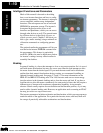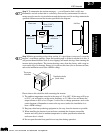
Frequently Asked Questions
Getting Started
1–14
exhibit leakage currents that increase with aging. And, a grounded chassis
generally emits less electrical noise than an ungrounded one.
Q. What type of motor is compatible with the Hitachi inverters?
A. Motor type – it must be a three phase AC induction motor. Use an inverter-
grade motor that has 800V insulation for 200V class inverters, or 1600V
insulation for 400V class.
Motor size – In practice, it’s better to find the right size motor for your
application; then look for the inverter to match the motor.
Q. How many poles should the motor have?
A. Using a four-pole motor will work for most applications. The greater the
number of poles, the slower the top motor speed will be, but it will have
higher torque at the slowest speed.
Q. Will I be able to add dynamic (resistive) braking to my Hitachi L100 drive after the
initial installation?
A. Yes. You can connect a dynamic braking unit to the L100 inverter. The
resistor in the braking unit must be sized to meet the braking requirements.
Q. How will I know if my application will require resistive braking?
A. For new applications, it may be difficult to tell before you actually test a
motor/drive solution. In general, some applications can rely on system losses
such as friction to serve as the decelerating force, or otherwise can tolerate a
long deceleration time. These applications will not need dynamic braking.
However, applications with a combination of a high-inertia load and a
required short decel time will need dynamic braking. This is a physics
question that may be answered either empirically or through extensive calcu-
lations.
Q. Several options related to electrical noise suppression are available for the Hitachi
inverters. How can I know if my application will require any of these options?
A. The purpose of these noise filters is to reduce the inverter electrical noise so
the operation of nearby electrical devices is not affected. Some applications
are governed by particular regulatory agencies, and noise suppression is
mandatory. In those cases, the inverter must have the corresponding noise
filter installed. Other applications may not need noise suppression, unless
you notice electrical interference with the operation of other devices.
Q. The L100 features a PID loop feature. PID loops are usually associated with
chemical processes, heating, or process industries in general. How could the PID
loop feature be useful in my application?
A. You will need to determine which main variable in your application the
motor affects. That is the process variable (PV) for the motor. Over time, a
faster motor speed will cause a faster change in the PV than a slow motor
speed will. By using the PID loop feature, the inverter commands the motor
to run at the optimal speed required to maintain the PV at the desired value
for current conditions. Using the PID loop feature will require an additional
sensor and other wiring, and is considered an advanced application.
Technologies Inc.
Toll Free: voice: 1-877-539-2542 fax: 1-800-539-2542 www.mgitech.com
Technologies Inc.
Toll Free: voice: 1-877-539-2542 fax: 1-800-539-2542 www.mgitech.com


















